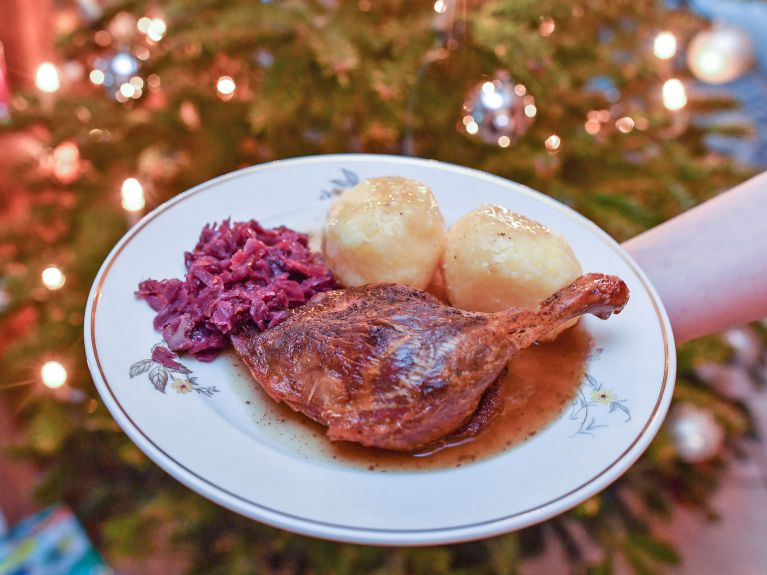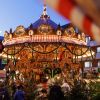Eating Christmas: Three Traditional German Dishes for December
One thing a German Christmas should always conjure: food, and plenty of it.

Yes, even in the birthplace of the Christmas tree, German Christmas cuisine shines brightest this time of year. Picture it: cruising the stalls of your local Weihnachtsmarkt. What’s the first thing you think of? Ticking off your holiday shopping list or heading for the nearest Glüwhein stall, and maybe picking up some Baumkuchen on the way?
We’re guessing the latter, and there’s good reason. Cuisine is a pillar of German Christmas tradition, dating back many centuries and, especially where baked goods are concerned, heavily influencing the way the rest of the world eats this time of year. There’s a season of eating to tackle, but for now, we’re taking a look at a few marquee dishes—the tip of the proverbial frosted iceberg—in German Christmas cuisine, including a traditional golden brown main, a spicy fixture of Christmas baking, and a classically rustic supper fit for any long winter’s night.
Christmas Tradition: Weihnachtsgans
The rest of the world waxes poetic about Christmas goose. Germans actually eat it, anchoring the Christmas table with a golden brown Gänsebraten that would make Dickens proud. Sure, duck is widely popular and perhaps even more common. But it’s also consumed in quantity elsewhere, whereas goose seems particularly German (2015 figures from Destatis show Germans eat 23,000 ton goose – 14,000 ton coming from Poland.. And it’s not a year-long love affair, either. Most of the geese “fly in” between October and December, with spikes at Christmas and New Year’s. Add that all up and you’ve got a definitively German Christmas tradition, one the next generation of cooks should keep up—and not just because roast goose happens to be delicious.
If the joy of being different isn’t enough to get you roasting, think of the history: Christmas goose has roots in everything from English superstition to religious asceticism. One legend has it that Queen Elizabeth I was gobbling up goose when she heard the British had defeated the Spanish Armada in 1588, ordering all of England to mimic her dinner at Christmas. The tradition then presumably spread from England to Germany, where it stuck. A second, homegrown explanation actually comes from a tradition of fasting: Medieval Christians would fast between St. Martin’s Day (November 11) and Christmas. Their dinner of choice before and after was goose, perhaps because—as legend has it—the reclusive St. Martin was said to have hidden among geese while trying to avoid becoming Bishop (the goose’s honk gave him away). But goose is also a prototypical “feast” item, plentiful, flavorful, and rich in fat—exactly the kind of thing you want to eat before 40 days of delayed gratification.
But the real reason to eat roast goose is all in the bird. Flavorful and rich (and not as aggressively farmed as its poultry counterparts), goose does exactly what you want protein to do in cold weather: roast up moist on the inside and crisp on the outside, all while bestowing you with a wealth of flavorful drippings for future cooking. Fortunately, especially if you’re going straight for tradition, roast goose is all about rusticity, so variations in recipes are typically minimal, more often seasoning-related. Several recipes rely on thyme or marjoram, its slightly earthy, verdant fragrance infusing the goose flesh from inside the cavity, while others steer toward the piney flavors of rosemary and staples like onions and apples. (Gordon Ramsay’s recipe incorporates Chinese five spice powder.) The point is you can pick and choose per your tastes—herbs, fresh and dried fruits, onions, various stuffings—so “tradition” doesn’t have to mean endless repetition.
When it comes time to roast, don’t fear the fat (geese have plenty, especially as farmers tend to aggressively fatten them for the holiday season). Just prepare for it. Some recipes recommend removing pockets of excess fat along with the giblets, but the most important thing to do is to prick the skin for drainage and siphon off the goose fat as it collects over the roasting period, which could last a few hours depending on size (most recipes call for an eight to 10 pound bird, which helps control flavor and evenness of cooking). If you’re inclined to keep the fat—do, it’s among the more coveted, with a high smoke point, “good” monounsaturated fat, and surprisingly less saturated fat than butter—have jars on hand for storage. (And follow directions.)
But the real beauty of Weihnachtsgans—what Dickens would admire most, we think—is that the final product isn’t overwhelmed with complicated side dishes, but allowed to shine—or glisten, more literally—alongside familiar, comforting staples like Spätzle, Knödel, and red cabbage. Leftovers, if you have any, might go into a fricassee, and even after the last bit of goose meat’s gone, you still have that delicious ganseschmalz, the gift that keeps on giving (confits, fried potatoes, dumplings, etc.) all year long.
Lebkuchen: The Ultimate Christmas Cookie
If Gänsebraten is our rustically German Christmas centerpiece, Lebkuchen is the perfect cookie to follow. In the constellation of German Christmas cookies (some native, some borrowed), Lebkuchen may shine brightest: a simple, pillowy gingerbread cookie built on robust flavors and a studiously perfected recipe. Also, not surprisingly, another Christmas dish with centuries of heritage.
The variously glazed, chocolate coated, nut- and citrus-flecked cookies that spill over bakery shelves and spice up the cold winter air this time of year actually date back to the Middle Ages, the most famous variant coming from Nürnberg, where monks in monastery kitchens would prepare cakes and spice cookies with honey collected from teeming local forests. In fact, if the idea of a Christmas spice cookie seems pat to us now, there’s actually a kind of historic logic to it: honey has an ancient reputation of importance (it was customarily offered as a gift to the gods by ancient Egyptians and Greeks). And now commonplace spices like cinnamon, nutmeg, and ginger were once heavily coveted and highly valued, with trade routes opening up all over the Orient in search of them. So ubiquitous Lebkuchen is actually both conceptually precious and implicitly celebratory—i.e., the ultimate Christmas cookie.
That’s not just exaggeration. Lebkuchen is easily one of the most serious cookie types in the world, complete with a centuries’ old league of Lebkuchen bakers and a designation of origin to protect recipe standards down to the slightest percent. Maybe it’s no surprise then that the basic recipe hasn’t changed much, typically highlighting honey and a heavy dose of spices (cinnamon, allspice, anise, clove, cardamom, ginger, etc.), with surrounding players like citrus peel, marzipan, nuts, and chocolate.
Of course, when a cookie’s a hit, slight variations inevitably sprout up. Classic Nürnberger Lebkuchen is a soft pile of gingerbread dough that’s baked onto oblaten, relatively flavorless bases that recall the communion wafers medieval monks would have used to give the cookies structure and prevent sticking. Brown Lebkuchen is rolled and typically baked without oblaten, while white Lebkuchen is named for its lighter dough, the result of high egg quantity. And then there are those ubiquitous hearts scrawled with messages of love, lining street fairs all over Germany. But the most prized Lebkuchen are easily the Elisen variety, supposedly named for the daughter of a gingerbread baker and distinctive for their low (to zero) flour content.
Whichever Lebkuchen your heart desires, and whether you bake or buy, be sure to store them correctly: the soft cookies require a slice of apple or citrus peel, to maintain moisture levels. Then again, they probably won’t last long enough for storage to be a problem.
Dieses YouTube-Video kann in einem neuen Tab abgespielt werden
YouTube öffnenThird party content
We use YouTube to embed content that may collect data about your activity. Please review the details and accept the service to see this content.
Open consent formChristmas and Beyond: Braised Hare
Rounding out this sampling of Germany’s Christmas panoply is actually a recipe that’s not Christmas specific, but suitable for any winter’s night that calls for edible warmth.
Hasenpfeffer, or braised hare stew, is one recipe in a long line of German stewing traditions, a classic hunter’s dish. And while it might have been made famous (or more famous) around the world in a classic American 1962 Looney Tunes cartoon (in which Yosemite Sam is ordered to prepare Hasenpfeffer for a grouchy king), the recipe, like Gänsebraten and Lebkuchen, is rooted in several hundred years of German history.
It’s not post-fast feasting or honey-exalting that inspired this recipe: it’s good old fashioned practicality. Imagine hunters traversing Germany’s thick, wintry forests hundreds of years ago, returning home to fire-lit cabins with several hare in tow and more than a few mouths to feed. Stew would have provided an easy way to stretch the protein (even in a winter-fattened hare, meat would be less plentiful than in deer or wild boar), with wine and spices tenderizing and enriching the meat over days of marinating, and accompaniments of potatoes or noodles making a fortifying meal of it.
In fact, like many old recipes, Hasenpfeffer is fundamentally pragmatic—hence its enduring charm. In days when preservation or meat quality was an issue, acid would’ve helped tenderize meat and kill bacteria, while heavy spices would have done double duty, helping to mask overly gamey or off flavors. And then there’s the hare’s blood, which could also be added as an additional fortifier and thickener (waste not, want not, after all). Of course, modern refrigeration and sourcing methods mean hunting and hygiene don’t have to be your foremost considerations in recipe prep.
If you do plan on cooking it, know what to expect: hare meat tends to be slightly gamey and sweet, perfect for a bracing red wine marinade, which both brings out and balances the meat’s natural flavors with depth and acidity. But what really makes this recipe are the spices infusing the stew, which vary but tend to include things like juniper berries, whole cloves, allspice berries, peppercorns, and rosemary—flavors that quite literally recall a forest in winter, the spice of bark, the sharp, clean fragrance of pine.
Now if that’s not something to eat at Christmastime in Germany—or whenever temperatures drop below freezing—we’re not sure what is.



